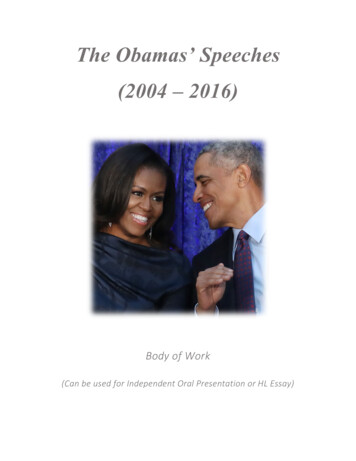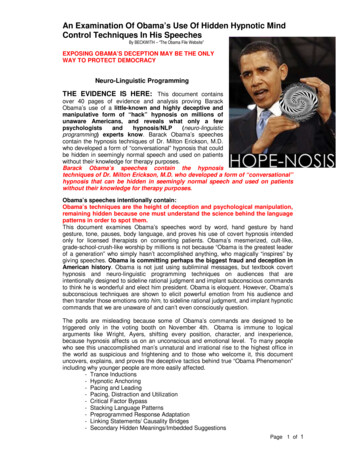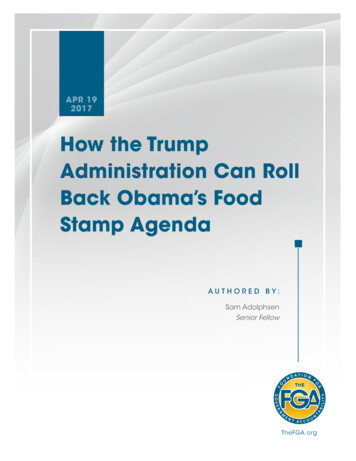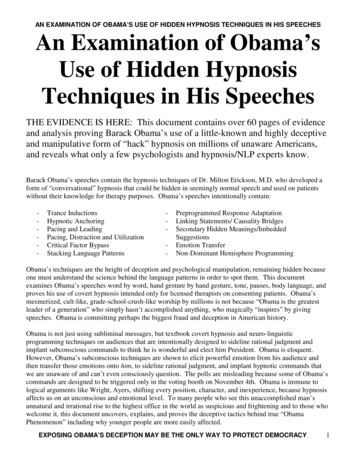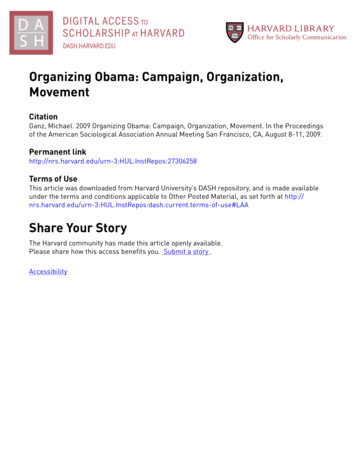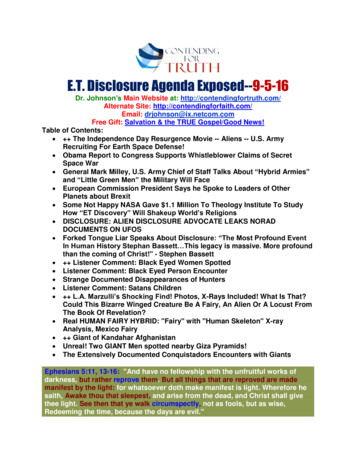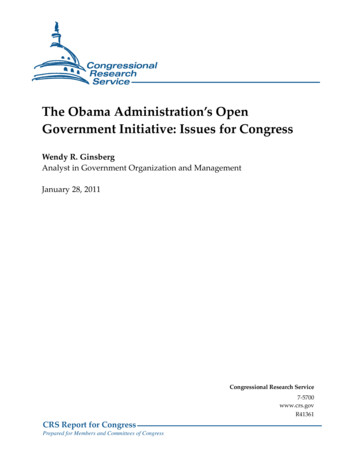
Transcription
The Obama Administration’s OpenGovernment Initiative: Issues for CongressWendy R. GinsbergAnalyst in Government Organization and ManagementJanuary 28, 2011Congressional Research Service7-5700www.crs.govR41361CRS Report for CongressPrepared for Members and Committees of Congress
The Obama Administration’s Open Government Initiative: Issues for CongressSummaryThe 112th Congress may have interest in accessing information and documents from the executivebranch. This report examines and analyzes the Obama Administration’s initiative to make theexecutive branch more transparent, participatory, and collaborative. On his first full day in office(January 21, 2009), President Barack Obama issued two memoranda “for the Heads of ExecutiveDepartments and Agencies” that were related to transparency in government. One memorandumfocused on the administration of the Freedom of Information Act (FOIA), and the other focusedon transparency and open government. The transparency memorandum committed theadministration to “an unprecedented level of openness” and to the establishment of “a system oftransparency, public participation, and collaboration.” Some scholars argue that these memorandawere a significant break from the policies of the previous administration.Over the next few months, the Office of Management and Budget (OMB)—a component of theExecutive Office of the President—administered a series of online public feedback forums as partof a comprehensive Open Government Initiative (OGI). Through the forums, OMB sought inputfrom federal employees and the public on ways to improve government transparency, increasepublic participation with the federal government, and encourage collaboration among federalgovernment agencies, private citizens, and other entities.On December 8, 2009, the Obama Administration released a third memorandum, an OpenGovernment Directive (OGD), that included more detailed instructions for departments andagencies on how they are to “implement the principles of transparency, participation, andcollaboration.” Among other policy initiatives, the memorandum required all federal agencies torelease three “high-value” datasets that were previously unpublished. In addition, thememorandum required each agency to designate a “high-level senior official to be accountable forthe quality and objectivity of, and internal controls over, the Federal spending information” thatagencies currently provide to government websites like USAspending.gov and Recovery.gov.Each agency was also required to create an “open government plan that will describe how itwill improve transparency and integrate public participation and collaboration into its activities.”The presidential memorandum included a series of staggered deadlines for implementing eachpart of the directive.Both the Administration and private organizations have examined federal agency efforts to meetthe OGD’s requirements. These examinations have found that agencies met the requirements, butwith varying results. Some agencies completed the OGD requirements by setting up requiredwebsites, but providing limited information or public participation. Other agencies exploredmethods of integrating their newly released datasets into their open government websites andproviding forums for the public to offer thoughts on ways to improve the sites further.The 112th Congress may oversee the Administration’s open government efforts and has theauthority to codify any parts of the initiative. This report reviews and discusses the centerpiecesof President Obama’s transparency initiatives, the Open Government Initiative and the OpenGovernment Directive. The report analyzes agency response to the OGI and the OGD andexamines whether the OGD’s requirements can meet the stated goals of the Administration. Thereport discusses the three central tenets of the Administration’s OGD—transparency, publicparticipation, and collaboration—and analyzes each one individually to determine whetheragencies are meeting these requirements and whether the requirements may improve theeffectiveness of the federal government.Congressional Research Service
The Obama Administration’s Open Government Initiative: Issues for CongressContentsIntroduction .1The Three Memoranda .2Government Transparency.3The Constitution and Transparency .4The Freedom of Information Act .5Significant Events May Affect Transparency Policies .6The Obama Administration .7The January 2009 Memoranda .7Starting the Open Government Initiative . 10Open Government Directive. 12Administration Leadership on the OGD . 12Publish Government Information Online . 14Datasets . 14Web Page. 15FOIA in the Open Government Directive . 17Improve the Quality of Government Information. 17Quality Information Framework. 18Federal Spending Transparency. 18Create and Institutionalize a Culture of Open Government . 19The Open Government Dashboard . 20Open Government Plan . 20Transparency Working Group. 23Incentive Structures. 24Create an Enabling Policy Framework for Open Government . 25Review of Existing Guidance . 25After the Open Government Directive . 26Analysis. 27Transparency . 28Public Participation. 30Collaboration . 31TablesTable 1. Requirements for Agencies to Publish Government Information Online . 17Table 2. Requirements for the Individual Agencies and Deputy Director for Managementat OMB to Improve the Quality of Government Information . 19Table 3. Requirements for Agencies and Government Officials to Create andInstitutionalize a Culture of Open Government. 24Table 4. Requirements for the OIRA Administrator, and the Federal CIO and CTO toReview Existing Guidance . 26Congressional Research Service
The Obama Administration’s Open Government Initiative: Issues for CongressContactsAuthor Contact Information . 32Congressional Research Service
The Obama Administration’s Open Government Initiative: Issues for CongressIntroductionMany Presidents have adopted policies to address the tension between government transparencyand protection of sensitive information. Sometimes these policies are more restrictive andprotective of institutional, commercial, and individual privacy as well as security concerns. Othertimes, however, policies have encouraged a presumption of disclosure of information.1 AnAdministration can issue its information policies in a variety of ways. For example, somePresidents issue their transparency policies through the Department of Justice (DOJ), as was doneduring the presidency of George W. Bush.2 In contrast, President Barack Obama issued threememoranda related to federal transparency from the Executive Office of the President during hisfirst year in office. In addition, the Office of Management and Budget (OMB), under the directionof the Obama Administration, underwent three phases of public information collection thatpresumably helped shape the Administration’s transparency initiatives.On his first full day in office (January 21, 2009), President Barack Obama issued two memoranda“for the Heads of Executive Departments and Agencies” that were related to transparency ingovernment.3 One memorandum focused on the administration of the Freedom of InformationAct (FOIA), and the other focused on transparency and open government. On December 6, 2009,OMB issued a third memorandum seeking to operationalize the concepts of transparency, publicparticipation, and collaboration.4Although each executive-branch agency met the deadlines set out in the December 6, 2009,memorandum, the Administration and some observers outside of government noted that theagency responses varied in quality. This report reviews the objectives delineated in PresidentObama’s Open Government Initiative (OGI) and examines the expectations placed on agencies tomeet these objectives. This report reviews department and agency attempts to implement ObamaAdministration initiatives that seek to make the federal government more transparent,participatory, and collaborative. The report then analyzes options for congressional action in thisarea.1The Administration of former President George W. Bush, for example, adopted a policy of “full and deliberateconsideration” of any requests for federal government information made by the public. See Memorandum from JohnAshcroft, Attorney General, to Heads of All Federal Departments and Agencies, October 12, 2001, http://www.doi.gov/foia/foia.pdf. The Administration of President Barack Obama, on the other hand, has stated its intention to adopt apolicy of presumptive disclosure that will be described in greater detail later in this report. See Memorandum fromPresident Barack Obama For Heads of Executive Departments and Agencies, January 21, 2009,http://www.whitehouse.gov/the press office/FreedomofInformationAct/.2John Ashcroft, Attorney General, Memorandum to the Heads of Federal Departments and Agencies: The Freedom ofInformation Act, Department of Justice, Washington, DC, October 12, 2001, http://www.doi.gov/foia/foia.pdf.3Executive Office of the President, “Freedom of Information Act,” 74 Federal Register 4693, January 26, 2009. Thememorandum was released on January 21, 2009, http://www.whitehouse.gov/the press office/FreedomofInformationAct/. Executive Office of the President, “Transparency and Open Government,” 74 FederalRegister 4685, January 26, 2009. The memorandum was released on January 21, 2009, http://www.whitehouse.gov/the press office/Transparency and Open Government/; and Executive Office of the President, “Transparency andOpen Government,” 74 Federal Register 4685, January 26, 2009. The memorandum was released on January 21, 2009,http://www.whitehouse.gov/the press office/Transparency and Open Government/.4Executive Office of the President, Office of Management and Budget, Memorandum for the Heads of ExecutiveDepartments and Agencies: Open Government Directive, Washington, DC, December 8, a 2010/m10-06.pdf.Congressional Research Service1
The Obama Administration’s Open Government Initiative: Issues for CongressThe Three MemorandaSince entering office, President Obama and his Administration have issued three memorandadirectly related to transparency and open government issues. Two of those memoranda werereleased on the President’s first full day in office. The third memorandum, which requiresagencies to implement certain open government ideas, was issued in December 2009.One of the two January 21, 2009, memoranda, the “Transparency and Open Government”memorandum, said that the new Administration was “committed to creating an unprecedentedlevel of openness in government.”5 The memorandum focused on fostering a more opengovernment based on three principles: transparency, public participation, and collaboration.The memorandum required the chief technology officer and the director of OMB to issue, within120 days, recommendations for the Open Government Directive “that instructs executivedepartments and agencies to take specific actions implementing the principles set forth in thismemorandum.”6The second January 21, 2009, memorandum, the “Freedom of Information Act” memorandum,said that FOIA “should be administered with a clear presumption: In the face of doubt, opennessprevails.”7 The memorandum said that under the new administration “ [a]ll agencies should adopta presumption in favor of disclosure, in order to renew their commitment to the principlesembodied in FOIA, and to usher in a new era of open Government. The presumption of disclosureshould be applied to all decisions involving FOIA.”8The memorandum then directed the attorney general to “issue new guidelines governing theFOIA to the heads of executive departments and agencies, reaffirming the commitment toaccountability and transparency, and to publish such guidelines in the Federal Register.”9In addition to the two memoranda, the Administration conducted a series of online public inputforums between January and July 2009, seeking feedback and ideas from federal employees, thepublic, and industry representatives on ways to make the federal government more transparent,collaborative, and participatory.On December 8, 2009, Peter R. Orszag, the director of OMB, released a third open-governmentrelated memorandum, the “Open Government Directive” memorandum, that included moredetailed instructions for departments and agencies on how to “implement the principles oftransparency, participation, and collaboration.”10 Among the initiatives in the memorandum was a5Executive Office of the President, “Transparency and Open Government,” 74 Federal Register 4685, January 26,2009. The memorandum was released on January 21, 2009, http://www.whitehouse.gov/the press office/Transparency and Open Government/.6Ibid.7Executive Office of the President, “Freedom of Information Act,” 74 Federal Register 4693, January 26, 2009. Thememorandum was released on January 21, 2009, http://www.whitehouse.gov/the press office/FreedomofInformationAct/.8Ibid.9Ibid. The memorandum did not include a deadline by which such guidelines must be published.10Executive Office of the President, Office of Management and Budget, Memorandum for the Heads of ExecutiveDepartments and Agencies: Open Government Directive, Washington, DC, December 8, 2009,(continued.)Congressional Research Service2
The Obama Administration’s Open Government Initiative: Issues for Congressrequirement to give the public access to “high-value” datasets that were previously unpublished.In addition, the memorandum required each agency to designate a “high-level senior official to beaccountable for the quality and objectivity of, and internal controls over, the Federal spendinginformation” that agencies currently provide to government websites like USAspending.gov andRecovery.gov. 11 Each agency was also required to create an “open government plan that willdescribe how it will improve transparency and integrate public participation and collaborationinto its activities.”12 The memorandum set a series of staggered deadlines for each department andagency to comply with the new requirements.This report examines the Obama Administration’s Open Government Initiative. It reviews theAdministration’s requirements for each executive-branch department and agency, and it examinesdepartment and agency results in increasing transparency, public participation, and collaboration.This report also analyzes options for congressional oversight and possible legislative andoversight actions in these areas.Government TransparencyThe tension between a transparent government and the maintenance of proper levels of secrecyhas existed throughout the nation’s history. Sometimes Congress or the President may choose tokeep information secret, arguing that it serves to protect national security or an individual’sprivacy. Other times the federal government may make information public in an attempt toincrease public trust in the deliberative democratic process. Scholars Sidney A. Shapiro and RenaI. Steinzor wrote in a 2006 article on executive branch secrecy and accountability that[c]laims that the executive branch needs extensive secrecy to operate effectively aretroublesome because of the important role transparency plays in the American constitutionalsystem of checks and balances. When secrecy becomes sufficiently pervasive, it becomesdifficult, even impossible, for Congress and the public to determine what is going on in theexecutive branch. Government failures are hidden and the public interest suffers. Indeed, it isnot an exaggeration to say that pervasive secrecy can fatally undermine the structure of ourconstitutional government by allowing the executive branch to withhold crucial informationfrom the other two branches and, as important, a free press.Nevertheless, absolute transparency is neither a realistic nor an appropriate goal. The releaseof some types of information can do more harm than good. The difficult public policyissue, of course, is striking an appropriate balance between openness and secrecy.13This section offers a brief overview of some critical documents and events that shapedgovernment transparency and information secrecy in the U.S. federal mb/assets/memoranda 2010/m10-06.pdf. It is unclear how much influence the onlineforums influenced the December 8, 2009, memorandum.11Ibid., p. 3.12Ibid., p. 4.13Sydney A. Shapiro and Rena I. Steinzor, “The People’s Agent: Executive Branch Secrecy and Accountability in anAge of Terrorism,” Law and Contemporary Problems, vol. 69, no. 99 (Summer 2006).Congressional Research Service3
The Obama Administration’s Open Government Initiative: Issues for CongressThe Constitution and TransparencyThe United States Constitution contains some of the same conflicts between transparency andsecrecy that continue to inspire debates in all three co-equal branches of the federal government.In Article I, Section 5, for example, the Constitution states thatEach House shall keep a Journal of its Proceedings, and from time to time publish the same,excepting such Parts as may in their Judgment require Secrecy; and the Yeas and Nays of theMembers of either House on any question shall, at the Desire of one fifth of those Present, beentered on the Journal.Pursuant to the Constitution, therefore, Congress is required to keep a publicly accessible recordof its actions, but is also given the authority to keep certain topics secret. The Constitution makesno specific reference to what subject matter could be kept secret by Congress, and leaves thatquestion to be answered by each chamber individually.The only explicit reference to the executive branch’s responsibilities to share governmentinformation is in Article II, Section 3, of the Constitution, which requires the President “fromtime to time” to “give to the Congress Information of the State of the Union, and recommend totheir Consideration such Measures as he shall judge necessary and expedient.” In modern times,this constitutional requirement has been filled by the annual State of the Union Address presentedto a joint session of Congress.14In addition to explicit constitutional requirements, implicit responsibilities and powers may befound in the Constitution. Oversight, for example, is an implicit constitutional power andobligation of the Congress.15 According to historian Arthur Schlesinger, Jr., “it was not considerednecessary to make an explicit grant of such [oversight] authority,” wrote Schlesinger. “The powerto make laws implied the power to see whether they were faithfully executed.”16 The Constitutionalso granted Congress an array of formal powers—the purse strings, lawmaking, impeachment,among others—to hold the president and the administration accountable for their actions orinactions. In short, oversight plays a key role in our system of checks and balances.Among the various methods Congress may use to conduct its oversight duties is creating andenforcing agency reporting requirements. Numerous laws require executive agencies to submitreports periodically, and as required by specific events or certain conditions, to Congress and itscommittees. As one scholar explained:Reporting requirements are provisions in laws requiring the executive branch to submitspecified information to Congress or committees of Congress. Their basic purpose is toprovide data and analysis Congress needs to oversee the implementation of legislation andforeign policy by the executive branch.1714For more information about the State of the Union Address, see CRS Report R40132, The President’s State of theUnion Address: Tradition, Function, and Policy Implications, by Colleen J. Shogan and Thomas H. Neale.15For more information on congressional oversight see CRS Report R41079, Congressional Oversight: An Overview,by Walter J. Oleszek.16Arthur M. Schlesinger, Jr. and Roger Burns, eds., Congress Investigates: A Documented History, 1792-1974, vol. 1(New York: Chelsea House, 1975), p. xix.17Ellen C. Collier, “Foreign Policy by Reporting Requirement,” Washington Quarterly, Winter 1988, p. 75.Congressional Research Service4
The Obama Administration’s Open Government Initiative: Issues for CongressGenerally, reporting requirements encourage self-evaluation by the executive branch and promoteagency accountability to Congress. Reporting requirements involve weighing Congress’s need forinformation and analysis to conduct evaluations of agencies and programs against the impositionof burdensome or unnecessary obligations on executive-branch entities.The executive branch has explicit statutory authorities and may claim additional implied powersto withhold certain documents or information from release. Most records of recent formerPresidents and former Vice Presidents, for example, are required by statute to be turned over tothe National Archives and Records Administration at the end of each administration, pursuant tothe Presidential Records Act.18 A series of executive orders,19 however, have modified how muchtime a former or incumbent president or vice president has to decide whether to block certainpresidential records from release. The Constitution makes no explicit reference to retainingpresidential records, nor does the Constitution explicitly authorize presidents to issue executiveorders. Both of these actions stem from implied presidential powers in the Constitution.The Freedom of Information ActIt was not until the 1966 enactment of the Freedom of Information Act (FOIA; 5 U.S.C. § 552)that individuals, corporations, and other entities were given “presumptive access to unpublished,existing and identifiable records of the agencies of the Federal executive branch without having todemonstrate a need or reason for such request.”20Although the original FOIA and its subsequent amendments make executive-branch documentsmore accessible to the public, the act includes nine exemptions that permit agencies to declinerequests for information:1. Information properly classified for national defense or foreign policy purposes assecret under criteria established by an executive order;2. Information relating solely to agency internal personnel rules and practices;3. Data specifically excepted from disclosure by a statute which either requires thatmatters be withheld in a non-discretionary manner or which establishes particularcriteria for withholding or refers to particular types of matters to be withheld;4. Trade secrets and commercial or financial information obtained from a person that isprivileged or confidential;5. Inter- or intra-agency memoranda or letters that would not be available by law exceptto an agency in litigation;18For more information on the Presidential Records Act and the preservation of presidential records, see CRS ReportR40238, Presidential Records: Issues for the 111th Congress, by Wendy R. Ginsberg.19For more information on executive orders, see CRS Report RS20846, Executive Orders: Issuance and Revocation,by Vanessa K. Burrows.20Harold C. Relyea, “Federal Freedom of Information Policy: Highlights of Recent Developments,” in GovernmentInformation Quarterly, vol. 26 (2009), p. 314. For more information on FOIA, see CRS Report R40766, Freedom ofInformation Act (FOIA): Issues for the 111th Congress, by Wendy R. Ginsberg.Congressional Research Service5
The Obama Administration’s Open Government Initiative: Issues for Congress6. Personnel, medical, or similar files the disclosure of which would constitute anunwarranted invasion of personal privacy;7. Certain kinds of investigatory records compiled for law enforcement purposes;8. Certain information relating to the regulation of financial institutions; and9. Geological and geophysical information and data. (5 U.S.C. § 552(b)).If a requester seeks information in one of the preceding nine categories, he or she is to be notifiedthat the request may not be filled. The agency is required to cite the exemption it is using torefuse the information request.A requester who is dissatisfied with an agency response to his or her request may pursue aremedy in the courts or seek arbitration at the Office of Government Information Services, whichis located in the National Archives and Records Administration.21Significant Events May Affect Transparency PoliciesAttitudes toward transparency can change over time, often affected by the political climate of thecountry or by significant events that may change opinions on what and how much informationshould be publicly available.For example, terrorist attacks on the World Trade Center in New York City and the Pentagon inWashington, DC, on September 11, 2001, prompted the George W. Bush Administration to adoptnew policies on accessing federal government information.One month after the September 11 attacks, for example, then-Attorney General John Ashcroftissued a memorandum redefining how FOIA was to be applied, saying agency and departmentheads should release documents “only after full and deliberate consideration of the institutional,commercial, and personal privacy interests that could be implicated by disclosure of theinformation.”22 The memorandum continued:When you carefully consider FOIA requests and decide to withhold records, in whole or inpart, you can be assured that the Department of Justice will defend your decisions unlessthey lack a sound legal basis or present an unwarranted risk of adverse impact on the abilityof other agencies to protect other important records.23Another significant event that may affect federal transparency was the November 2010 publicrelease of classified Department of State documents on Wikileaks.org. The published informationincluded a small portion of more than 250,000 classified diplomatic cables the website claims tohave. 24 Some diplomats may now fear the information they write in such cables could be released21The National Archives, “The Office of Government Information Services,” http://www.archives.gov/ogis/.22Attorney General John Ashcroft, Memorandum For the Heads of All Federal Departments and Agencies,Department of Justice, The Freedom of Information Act, Washington, DC, October 12, 2001, http://www.doi.gov/foia/foia.pdf.23Ibid.24For example, see Karen DeYoung and John Pomfret, “U.S. Downplays Impact of Leaks,” Washington Post,November 30, 2010, gressional Research Service6
The Obama Administration’s Open Government Initiative: Issues for Congressto the public, and may, therefore, be “more cautious” about their contents.25 Secretary of StateHillary R. Clinton called the Wikileaks.org release “not just an attack on America’s foreign policyinterests. It is an attack on the international community—the alliances and partnerships, theconversations and negotiations, that safeguard global security and advance economicprosperity.”26 Secret
embodied in FOIA, and to usher in a new era of open Government. The presumption of disclosure should be applied to all decisions involving FOIA."8 The memorandum then directed the attorney general to "issue new guidelines governing the FOIA to the heads of executive departments and agencies, reaffirming the commitment to



